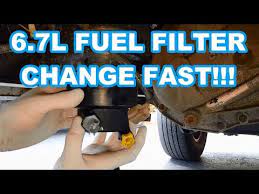How to Drain Water From Fuel Filter Diesel
If the “Water in fuel” warning light illuminates, it is imperative that you drain any standing water from the filter diesel before driving again – this simple step will prevent corrosion in your vehicle’s fuel system and save money in maintenance costs.
Diesel fuel absorbs moisture more readily than gasoline does, so diesel filters must include a bowl at the base of their filter where this excess moisture collects.
Vent Valve
Modern diesel vehicles usually include water separators that clean themselves automatically; older trucks require that you do this yourself manually. As this task allows clean fuel to pass through your diesel engine’s injector system, it should be part of your regular filter change routine.
Release the vent valve located at the top of your separator’s housing to allow air into it and release its pressure, or, if your model doesn’t feature one, loosen and drain the top-most fuel pipe union connected to the filter housing until only clean diesel fuel flows out. Repeat these steps until only clean diesel fuel flows out.
Alternately, you can extend the factory drain hose at the chassis mounted filter with some 3/8″ clear vinyl hose from a hardware store. This will enable you to use ignition-on purging of the chassis-mounted filter while keeping a water bottle nearby – just ensure to drain excess fluid into a container that will collect it as it comes from your pump.
Fuel Pipe
Many older diesel vehicles do not feature auto-cleaning water separators and must have their fuel filters manually drained to remove contaminants and moisture that could potentially lead to microorganism growth that would be difficult or impossible to eradicate.
Draining off water and contaminants may prevent clogs in the fuel filter and damage to internal components that isn’t covered under warranty. Draining off any extraneous fluids could help avoid these issues.
When draining fuel from a tank, the easiest and simplest method is to place a container beneath its drainage plug and open its plug, which will allow fuel to start flowing freely out over several minutes. Once all the liquid has drained off, close and replace your drain cap – however a fuel additive could help minimize moisture in your tank, helping prevent fuel degradation over time.
Petcock
Most diesel vehicles use a water separator in the fuel filter, with its drain opened by a small plug or tap known as a petcock. This device allows water and contaminants to exit its collection chamber without needing to remove or unplug the filter itself.
Water in diesel can ruin both your fuel pump and injectors, while its corrosion can clog the injection system’s clearances, making it harder than ever for you to get clean fuel into your engine and leading to misfires – both common problems among diesel engines.
Water should be regularly removed from your fuel filter diesel system to maintain optimal performance and health. Doing this requires two simple steps – first off turning off the tank feed valve to stop any fuel being drawn back into the separator, followed by opening the drain cock and waiting until clean diesel begins flowing out through it.
Drain Plug or Tap
An effective solution for water in fuel can be achieved using a drain plug or tap. Simply loosening the vent valve at the top of the filter housing or disconnecting any uppermost fuel pipe unions connected to the filter case (if applicable) allows water to drain until clean diesel flows out; close drain plug or tap and tighten vent valve or fuel pipe afterwards.
Draining the collection bowl of your fuel filter/water separator periodically is highly recommended, especially during cooler temperatures when more moisture can collect in your system and cause freeze-up, particularly at its primary filter and bowl. This prevents any potential issues with frozen pipes or fuel lines requiring repairs later.
Water contamination of diesel fuel creates an unpleasant sludge, which clogs filters, damages pumps, and can even seep into engines. Preventing these issues from happening is best; but if they already exist then draining out and using water absorbers like Aquafighter might be necessary to rectify them.




Post Comment